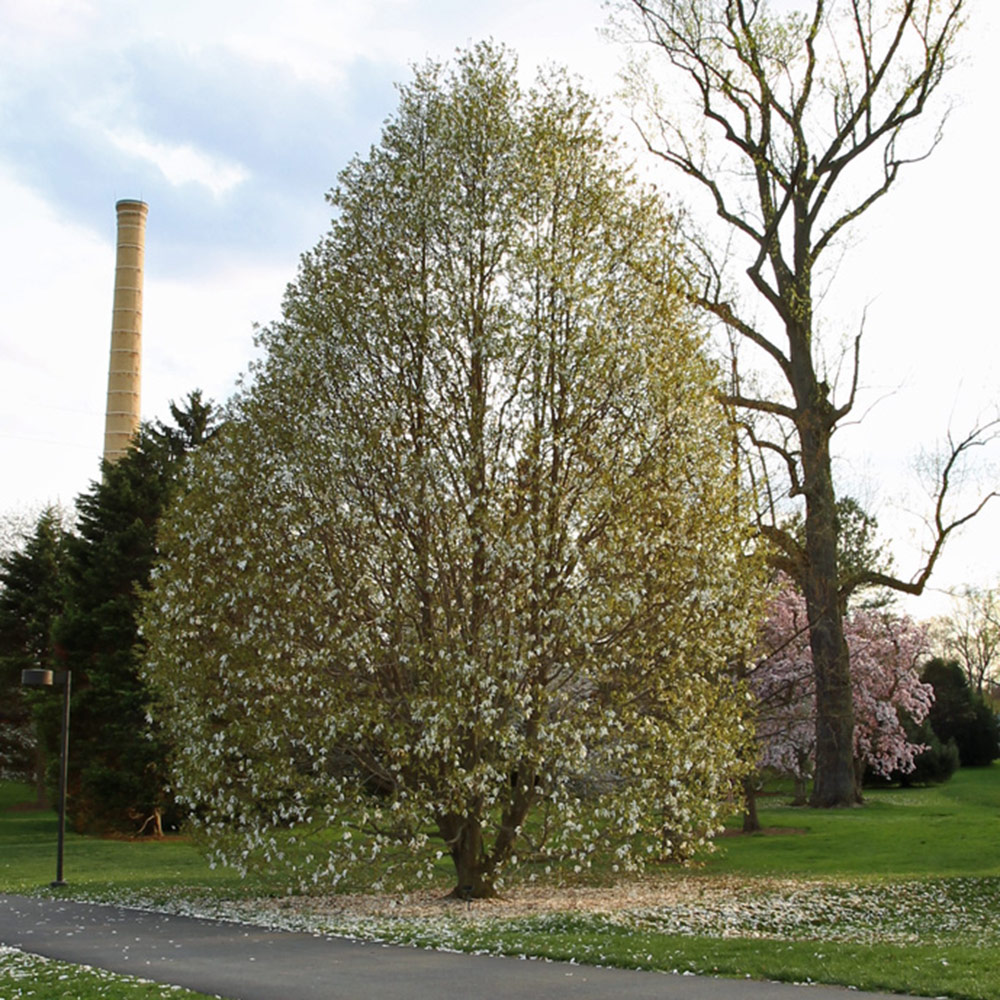Millions of years of evolution and hybridization efforts by generations of enthusiasts have produced hundreds of magnolia species and cultivars. Our mild Mid-Atlantic climate is conducive for growing a significant majority of them, which makes it quite daunting to select just one perfect specimen. From my long list of favorites, here are a few stellar selections with some of the best traits that this ancient genus has to offer.
‘Butterflies’ magnolia warmly greets spring with sunny blooms
Magnolia ‘Butterflies’
Zones: 5–9
Size: 15 to 20 feet tall and 10 to 15 feet wide
Conditions: Full sun to partial shade; moist, well-drained soil
Small trees with yellow early spring blooms are often hard to come by, which explains my attraction to this lovely little hybrid. Compared to other yellow-flowered magnolias, which tend to have blooms that fade quickly and color that is a bit muddy, ‘Butterflies’ is unique. Its upright, 8-inch, tulip-shaped flowers have a nonfading pure canary yellow hue and a light, lemony fragrance. It is smaller in stature than many other selections, which makes it a suitable choice for smaller gardens.

‘Wada’s Memory’ blooms at a very early age
Magnolia × kewensis ‘Wada’s Memory’
Zones: 5–8
Size: 25 to 30 feet tall and 15 to 20 feet wide
Conditions: Full sun to partial shade; moist, well-drained soil
Many deciduous magnolias develop a very asymmetrical, unpredictable habit with age and maturity, making it quite a challenge to site them in spaces that are not large and open. That is not the case with ‘Wada’s Memory’, which develops and maintains a very symmetrical, pyramidal shape from a young age. It also begins blooming at a very young age compared to other magnolias. The abundant, pure white, 7-inch flowers burst forth before foliage emerges in early spring, filling the garden with a delightful orange-blossom fragrance.

Moonglow® sweet bay magnolia reblooms throughout the growing season
Magnolia virginiana ‘Jim Wilson’
Zones: 5–10
Size: 15 to 35 feet tall and 10 to 20 feet wide
Conditions: Full sun to partial shade; moist to wet soil
Native plant enthusiasts, this is the magnolia for you. Sweet bay magnolia naturally occurs along much of the Atlantic coast and is very adaptable to a variety of growing conditions, including wet soil. Compared with the straight species, Moonglow® has a more vigorous, upright habit and is more cold hardy. Its glossy, dark green foliage with silvery undersides is retained and remains evergreen during the winter months. Emerging in spring, its pure white, slightly cupped, fragrant flowers are larger than those of the straight species, and it may also produce flowers sporadically throughout the growing season. Bright red seeds in conelike fruits add to the appeal of this excellent cultivar.

“The Girls” bloom later than other cultivars, so their flowers are less likely to be nipped by frost
Magnolia ‘Ann’, ‘Betty’, ‘Jane’, ‘Judy’, ‘Pinkie’, ‘Randy’, ‘Ricki’, and ‘Susan’
Zones: 4–8
Size: 10 to 15 feet tall and wide
Conditions: Full sun to partial shade; moist, well-drained soil
Many magnolias bloom very early, so late frosts or freezing temperatures often cause significant damage to their floral displays. The Little Girl series was developed at the National Arboretum in the 1950s to remedy that problem. The project produced eight selections, listed above, that flower two to four weeks later than many of the early-blooming magnolias such as saucer magnolia (M. × soulangiana, Zones 4–9) and star magnolia (M. stellata, Zones 4–8). Each of “the girls” has her own distinct personality. ‘Ann’ has a compact, shrublike, multistem habit and mildly fragrant, deep purple to pink flowers that appear from mid-April to May. Although less abundant than the initial flush, additional blooms may develop throughout the summer months. Others in the series grow in a similar manner, with flower color being the main difference between them. ‘Judy’, for example, has flowers that are red to purple on the outside and creamy white inside, while ‘Ricki’ has reddish to purple blooms with slightly less saturated hues on the interior.

‘D. D. Blanchard’ southern magnolia provides striking winter interest
Magnolia grandiflora ‘D. D. Blanchard’
Zones: 7–9
Size: 35 to 50 feet tall and 20 to 35 feet wide
Conditions: Full sun to partial shade; moist, well-drained soil
This stately specimen deserves a home in any garden that can accommodate its sizable habit. However, in smaller spaces I have seen it trained as an espalier or pruned into a formal shape with great success. To my eye, the deep-green, high-gloss foliage with rich velvety rust to brown undersides make it far superior to any of the other southern magnolias, with the possible exception of Teddy Bear® (Magnolia grandiflora ‘Southern Charm’, Zones 7–9), which you can read about here. Foliage creates a beautiful backdrop for equally lovely flowers. From late spring to early summer, dinner plate–size blooms produce a spicy, lemony aroma that perfumes the air surrounding this magnificent specimen.
Adam Glas is a garden supervisor and rosarian at the Scott Arboretum of Swarthmore College in Swarthmore, Pennsylvania.
For more Mid-Atlantic regional reports, click here.
Further reading:





